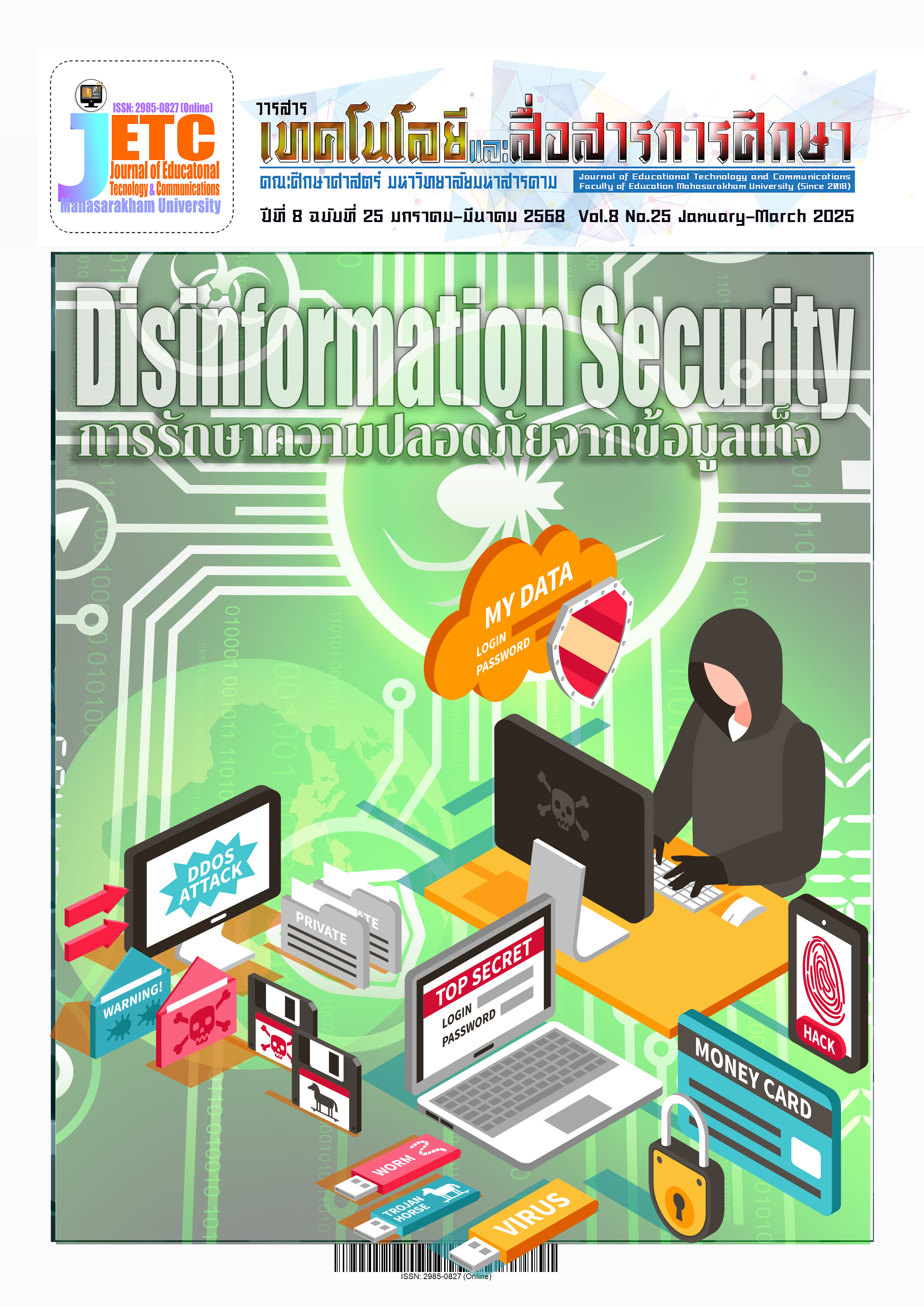การวิเคราะห์และเปรียบเทียบอัลกอริธึมการเรียนรู้ของเครื่องสำหรับการตรวจจับภัยคุกคามแบบ Zero-Day ในระบบเครือข่าย
Main Article Content
บทคัดย่อ
ผลการวิจัยพบว่า Neural Networks (NN) มีความแม่นยำ (Accuracy) สูงถึง 95.2% และอัตราการแจ้งเตือนผิดพลาด (False Positive Rate: FPR) ต่ำเพียง 2.5% ความสามารถนี้สะท้อนถึงประสิทธิภาพในการเรียนรู้ข้อมูลใหม่ที่ไม่เคยพบมาก่อน และการตอบสนองต่อภัยคุกคาม Zero-Day ได้อย่างแม่นยำ โดยช่วยลดภาระในการจัดการแจ้งเตือนผิดพลาด และเพิ่มประสิทธิภาพในการป้องกันระบบเครือข่าย RF และ SVM ซึ่งมีความแม่นยำ 90.5% และ 88.7% ตามลำดับ แม้จะให้ผลลัพธ์ที่ดี แต่ยังด้อยกว่า NN ในการลด FPR การใช้เทคนิค Anomaly Detection และ Ensemble Models ยังช่วยเพิ่มศักยภาพในการตรวจจับภัยคุกคามที่ซับซ้อนและรองรับสภาพแวดล้อมที่เปลี่ยนแปลงได้ระบบที่พัฒนาขึ้นสามารถบล็อก IP ที่เคยโจมตีซ้ำและตรวจจับพฤติกรรมผิดปกติได้รวดเร็ว เพิ่มความสามารถในการป้องกันภัยคุกคามใหม่ ๆ ที่ระบบเดิมไม่สามารถจัดการได้ การวิจัยนี้เสนอแนวทางพัฒนาระบบรักษาความปลอดภัยให้มีความแม่นยำและยืดหยุ่นต่อภัยคุกคามที่ซับซ้อนและเปลี่ยนแปลงได้ในอนาคต พร้อมเน้นย้ำถึงความสำคัญของการพัฒนาเทคโนโลยี Machine Learning ในการเสริมสร้างความมั่นคงทางไซเบอร์
Downloads
Article Details
References
Chua, Y. F., & Salam, R. A. (2023). Evaluation of machine learning algorithms in network-based intrusion detection using progressive dataset. Symmetry, 15(6), 1-31. https://doi.org/10.3390/sym15061251
Dawadi, B. R., Adhikari, B., & Srivastava, D. K. (2023). Deep learning technique-enabled web application firewall for the detection of web attacks. Sensors, 23(4), 1-16. https://doi.org/10.3390/s23042073
Dean, J. (2022). A golden decade of deep learning: Computing systems & applications. Dædalus, the Journal of the American Academy of Arts & Sciences, 151(2), 58-74. https://doi.org/10.1162/daed_a_01900
Gupta, I., Kumari, S., Jha, P., & Ghosh, M. (2024). Leveraging LSTM and GAN for modern malware detection. arXiv. https://doi.org/10.48550/arXiv.2405.04373
Kumar, P. S., B, U. S., Mishra, I., S, S. S., Tripathi, D. R., & Rama Krishna T., S. (2022). Malware detection classification using recurrent neural network. In 2022 2nd International Conference on Technological Advancements in Computational Sciences (ICTACS). (876–880). IEEE. https://doi.org/10.1109/ICTACS56270.2022.9988624
Salem, A. H., Azzam, S. M., Emam, O. E., & Abohany, A. A. (2024). Advancing cybersecurity: A comprehensive review of AI-driven detection techniques. Journal of Big Data, 11(105), 1-38. https://doi.org/10.1186/s40537-024-00957-y
Sarhan, M., Layeghy, S., Gallagher, M., & Portmann, M. (2023). From zero-shot machine learning to zero-day attack detection. International Journal of Information Security, 22(6), 947–959. https://link.springer.com/article/10.1007/s10207-023-00676-0
Sewak, M., Sahay, S. K., & Rathore, H. (2022). Deep reinforcement learning for cybersecurity threat detection and protection: A review. arXiv preprint arXiv:2206.02733. https://arxiv.org/abs/2206.02733
Singh, S., Kumar, R., Payra, S., & Singh, S. K. (2023). Artificial intelligence and machine learning in pharmacological research: Bridging the gap between data and drug discovery. Cureus, 15(8), e44359. https://doi.org/10.7759/cureus.44359
Yanguema, A. (2023). Fortifying network security with machine learning.SSRN. 1-9 https://doi.org/10.2139/ssrn.4663593

